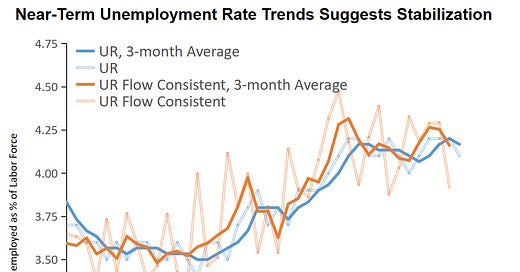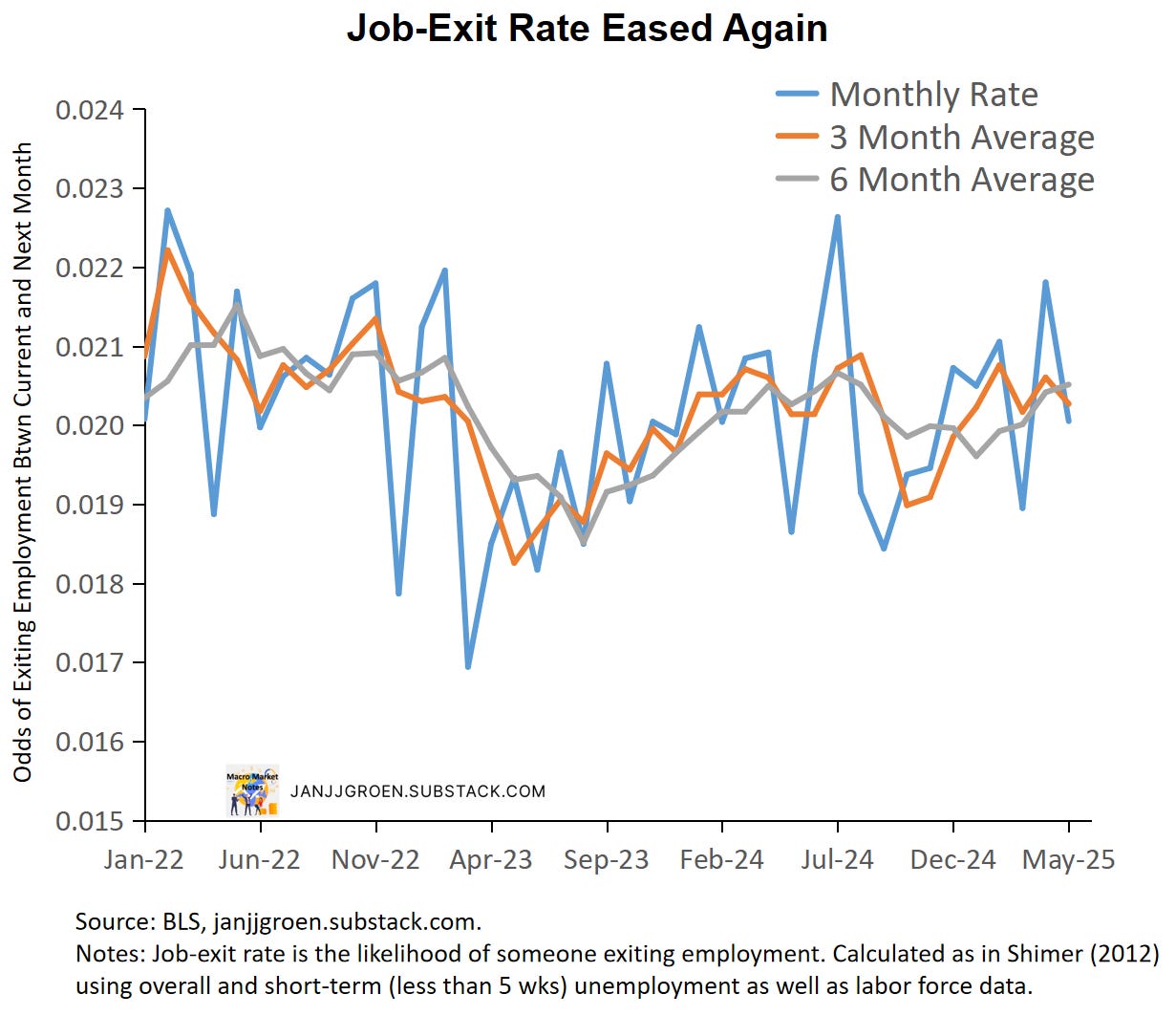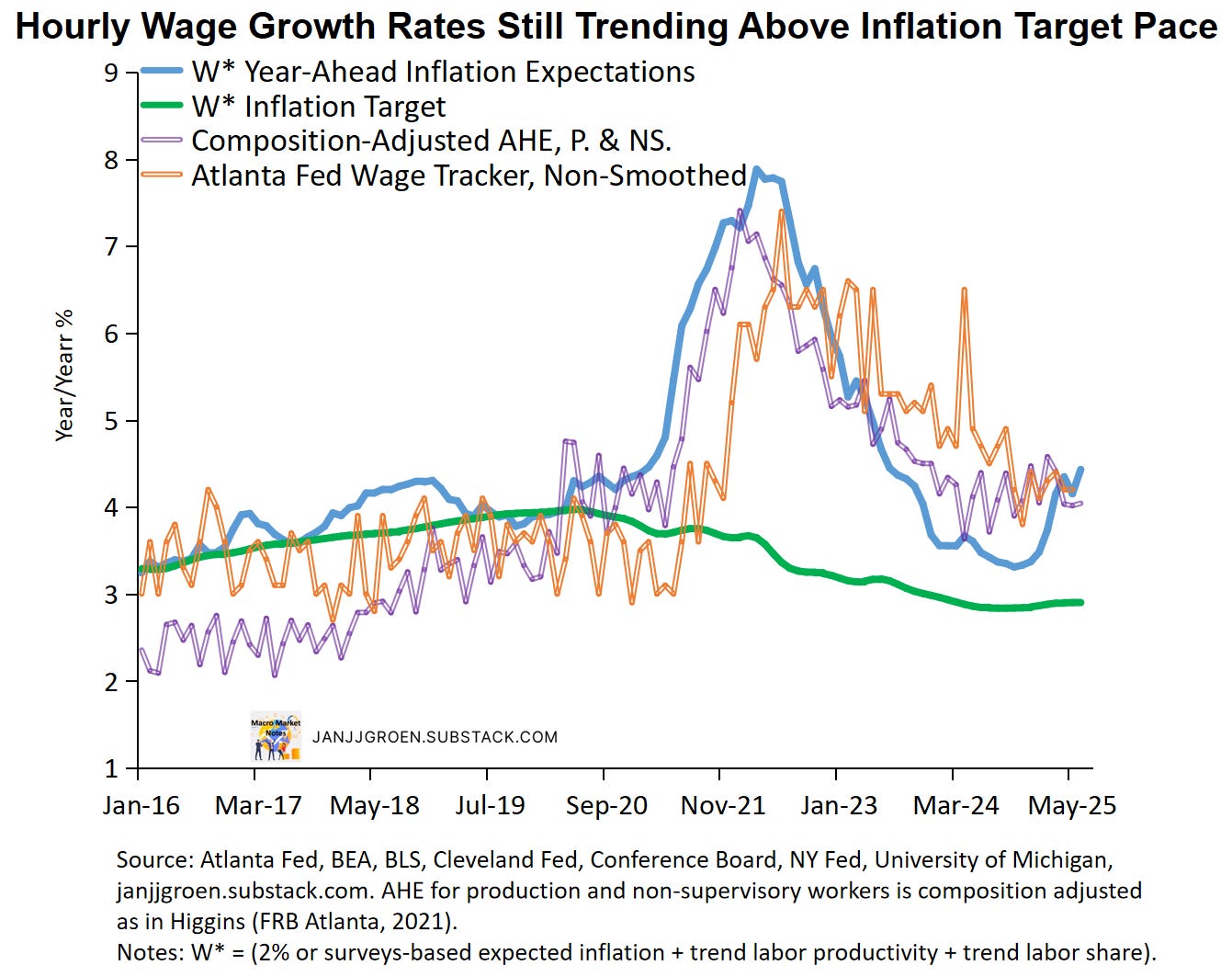June Payrolls: Carry On
Payrolls growth in June remained solid, and the unemployment rate ticked down. Wage growth slowed but the trend remains elevated vs inflation target pace.
The June Employment Situation report showed a solid pace of payrolls growth, and a decline in the unemployment rate as the job-exit rate dropped, and the job-finding rate increased. Hourly wage growth slowed but its trend remains above the 2% inflation pace - similar to what we have seen in previous reports. The payrolls growth trend still lags a still elevated breakeven pace based on more realistic population growth projections.
Key takeaways:
Payrolls growth was again solid in June, but near-term trends continue to run below the breakeven pace needed to keep the unemployment rate constant at current levels based on higher population projections.
The unemployment rate decreased 10bps to 4.1% as the labor force participation rate declined to 62.3%.
The job-finding rate increased somewhat over the month to 49% with smoothed trends around 47%. The unemployment rate consistent with recent job-exit and job-finding rates fell and smoothed trends suggest that in the near term the unemployment rate will likely increase and stabilize in the 4.2%-4.3% range.
Wage growth based on composition-adjusted average hourly earnings decelerated but annual trends remain at paces inconsistent with the 2% inflation target.
The Fed is confronted with a very uncertain outlook owing to the Trump Administration’s tariff and budget policies. Given a labor market that’s slowing gradually, still elevated inflation expectations and equally elevated and sticky underlying inflation trends, I continue to expect the Fed to remain on hold this year.
June Jobs Growth: A Positive Surprise
The June jobs report indicated that payrolls in the establishment survey grew stronger than the consensus expectation (+110,000 persons) as they were up by 147,000 persons in June, compared to a 144,000 increase in the preceding month (which was revised up from 139,000 initially). Payrolls growth for April and May combined were revised up by 16,000 persons.
The unemployment rate declined 10bps to 4.1% in June. In three-digit terms the unemployment rate fell from 4.244% in May to 4.117%, which is the first decline in the three-digit unemployment rate in 2025. Household employment grew 93,000 after decreasing 696,000 persons in May. Finally, the labor force participation rate declined in June for the second consecutive month from 62.4% to 62.3%.
Underlying Labor Market Trends
Both the monthly and three-month moving averages of payrolls changes from the establishment survey since February 2022 are shown in the chart above. The smoothed trend in payrolls growth decelerated in Q1 but gradually picked up the pace again throughout Q2 (orange line).
It’s useful to compare this smoothed trend with the estimate of the breakeven payrolls growth pace that keeps the unemployment rate constant in a given month conditional on the BLS’ population growth estimates as well as the labor force participation rate in that month. As was the case for most of 2024 this particular breakeven pace was just below 112,000 persons in June (purple line in the above chart). Compared to the three-month average payrolls growth rate this would suggest that the labor market is still creating more jobs than what would be consistent with a 4.1% unemployment rate.
But, while in January the BLS adjusted its population level for upgraded net immigration projections, the pre-2025 population remained uncorrected and remains well behind pre-2025 population estimates from other institutions like the CBO. The CBO estimates that the working population grew 1.4% in both 2023 and 2024, with the pace to slow down in 2025 to 0.9%. Based on these projections I’ve included in the above chart an adjusted breakeven payrolls growth pace for a constant unemployment rate that adjusts the BLS’ population projections for 2020-2025 to bring them line with the CBO’s 2020-2025 noninstitutionalized population estimates (gray line in the chart above).
The CBO-implied breakeven pace consistent with a stable unemployment rate at 4.1% was around 185,000 persons in June, down from about 192,000 in May as well as its 224,000 persons peak in December. Comparing this to the three-month average payrolls growth rate (orange vs. gray lines in the above chart) suggests that current job growth trends are still lagging this more realistic breakeven pace, with the monthly increase (147,000) also remaining somewhat below it. So, there remain upside risks to the unemployment rate over the near-term.
Additional details about the underlying strength of the labor market can be inferred from the household employment survey. Following Shimer (AER, 2005) and Shimer (RED, 2012), we can use data on total unemployed and employed persons as well as the number of people that are unemployed for less than 5 weeks to estimate:
Job-finding rate: the probability an unemployed person in month t will find a job or leaves the labor force. This is calculated assuming that total unemployment in month t+1 equals month t unemployment plus the number of people unemployed for less than 5 weeks in month t+1.1
Job-exit rate: the likelihood an employed person in month t will exit its job either due to layoffs, quits or retirement, which depends on data on the job-finding rate, unemployment and labor force.2
The chart above shows a plot for the estimated job-exit rate. This job-exit rate has been relatively stable over the past three years, with a moderate downward shift in the first half of 2023 that stabilized between June and October but then rose again until last summer. Note, however, that the y-axis in the chart above also makes clear that the variability in the separation rate has been really modest.
More recently, the job-exit rate eased between January and February but then increased again since April (chart above). This is in line with recent trends in jobless claims, with initial claims running above replacement levels since late Q1. During the past month, however, the exit rate eased somewhat.
This year the job-findings rate initially remained relatively range-bound (chart above) but dropped noticeably in March going into April. In May, however, the likelihood to exit unemployment bounced back notably. The overall number of unemployed persons in June declined more than the number of newly unemployed persons (less than 5 weeks in duration): -222,000 vs. -210,000. Given that the job-finding rate is essentially driven by the relative differential of increases in overall unemployment and newly unemployment, the estimated job-finding rate between May and June increased again (albeit slightly), and hovers around 49% which is the highest level this year (chart above). Three- and six-month averaged job-finding rates have been stable around 47%.
As in Shimer (AER, 2005) we can combine the above discussed job-exit and job-finding rates to calculate a flow-consistent unemployment rate and the chart above plots both the corresponding monthly rate and the three-month average of this rate. The (three-month average) flow-consistent unemployment rate is the unemployment rate that prevails when the job-exit and job-finding rates remain constant at their current (three-month average) levels. Deviations compared to the official unemployment rate should dissipate over time and frequently predict future changes in the official rate.
In terms of flows both the job-exit rate (layoffs) and the job-finding rate (hiring) moved in a positive direction — the chart above shows that this led to a notable drop in the monthly flow-consistent unemployment rate for May into June to 3.9%. Given the choppiness in this measure, it’s probably more useful to look at three-month averages.
The three-month averages of headline and flow-consistent unemployment rates had been broadly similar between September and February (solid blue and orange lines in the chart above) suggesting stabilization of the unemployment rate around 4.2%. Since then, however, the three-month averaged flow-consistent unemployment rate has been overshooting its headline counterpart, which would suggest a persistent shift up in the unemployment rate would be forthcoming. This wedge disappeared in this jobs report with both headline and flow-consistent three-month averages now hovering in the 4.2%-4.3% range.
Both smoothed payrolls growth trends and the job flows data show signs that the labor market is gradually slowing, with the unemployment rate likely to drift up and stabilize in the 4.2%-4.3% range over the near-term.
Wage Growth Pace Dropped
Average hourly earnings of all private sector employees grew 0.2% month/month in June, down from (an unrevised) 0.4% in May, and in year/year terms it declined slightly from (a downwardly revised) 3.8% in May to 3.7%. For production and non-supervisory workers, hourly earnings growth remained broadly unchanged at 0.3% (May was revised down from 0.4% to 0.3%) and on a year/year basis it also was essentially stable around 3.9% (May was revised down from 4.1% to 3.9%).
The wage data from the jobs report are notoriously noisy, given that they are revised often and do not correct for the sectoral and skills composition of jobs growth over the month. There are better quality wage data available, such as the Atlanta Fed Wage Growth Tracker and the Employment Cost Index, but the Atlanta Fed does construct a rudimentary composition correction for average hourly earnings from the jobs report, which can be found here.
When applying the Atlanta Fed composition correction on the monthly average hourly earnings for May, the correction kept the growth rate for all private workers unchanged at 0.2% but kept May at 0.4% (as opposed to a downward revision in the official data). For production & non-supervisory workers, this correction did change the finding of an unchanged pace of 0.3% pace for both May and June in the official data.
From the chart above one can observe that the three-month wage growth rate has eased substantially since March to about a 2.8% annualized pace in June. Note that revisions to the monthly data as well as seasonal adjustments could change this finding a lot in future jobs reports. The six- and 12-month wage growth rates (with the latter based on non-seasonally adjusted data) have remained relatively stable around 4%, which has been their trends over the past year to year-and-half.
I can combine labor productivity and labor share trend estimates with the 2% inflation target, along the lines I have done in my “Wages and Inflation Expectations” notes and incorporating the 2025 Q1 update of productivity data to get a medium-run annual wage growth rate consistent with 2% inflation.
Additionally, instead of the 2% target one can use my “Main Street” year-ahead inflation expectations proxy, i.e., the common trend across survey-based near-term inflation expectations from firm and consumer surveys. After incorporating June data for the (preliminary) University of Michigan and Atlanta Fed surveys this estimate suggests "Main Street" inflation expectations rose from 2.4% y/y PCE in Q4 to 3.3% in March and continued Upward to 3.5% in June. This reinforces that firms and households remain uneasy about near-term inflation amidst persistent policy uncertainty.
Compared to both the composition-adjusted AHE data for production and non-supervisory workers for June and the unsmoothed Atlanta Fed wage tracker into May, annual wage growth rates still outpace the 2.9% year/year pace consistent with 2% PCE inflation in the medium term (green line in the above chart). Current wage growth, however, does seem broadly consistent with a 3%-3.5% PCE inflation range implied by “Main Street” near-term inflation expectations for June (blue line in the chart above).
After the conclusion of the June FOMC meeting the Fed continued to signal that given a labor market that still is in a fairly good shape, the Fed can be patient and assess how the administration’s policies will adversely impact the inflation outlook. Elevated inflation expectations seem to validate such a cautious approach to further rate cuts, with many FOMC members again shifting up their inflation outlook for this year. The June jobs report continued show evidence of a gradually slowing labor market that may stabilize in the near term. Furthermore, while wage growth momentum slowed recently, wage growth trends continue to run at rates well above the pace consistent with 2% inflation over the medium-term — more likely in line with 3% inflation. So, given today’s report, still elevated “Main Street” inflation expectations, and equally elevated and sticky underlying inflation trends I continue to expect the Fed to remain on hold this year.
Given this calculation, the job-finding rate will run up to May utilizing data on (short-term) unemployment for June.
As the calculation of the job-separation rate depends also on (short-term) unemployment for June, we cannot go beyond May.









